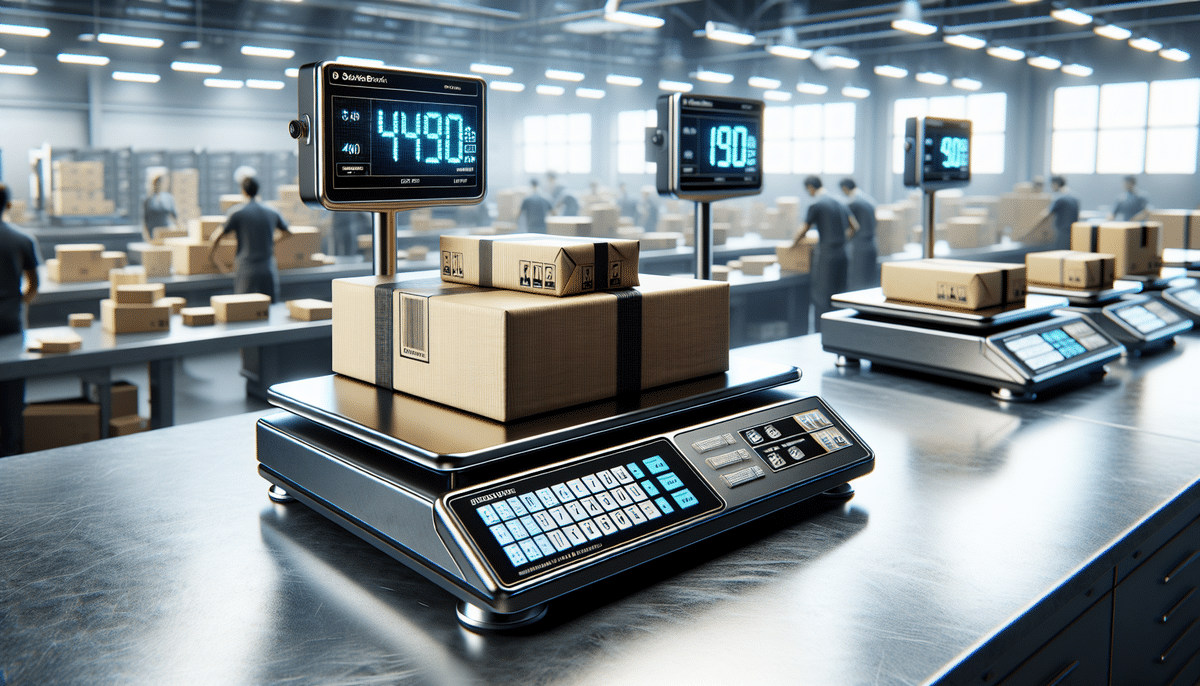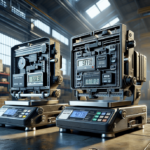Introduction to the Digital Scales Market
The digital scales market is highly competitive, offering a plethora of brands and models tailored to various business needs. Among these, Smart Weigh and Salter Brecknell have carved out significant market shares due to their commitment to reliability, accuracy, and durability. According to a 2023 Forbes report, the global digital scale market is projected to grow by 5.7% annually, driven by the expanding e-commerce sector.
Product Overviews
Smart Weigh Digital Heavy Duty Shipping and Postal Scale
The Smart Weigh Digital Heavy Duty Shipping and Postal Scale is a favored choice among businesses that prioritize precise weight measurements for shipping operations. With a weight capacity of up to 440 pounds (200 kilograms), it accommodates both small and large packages with ease. Key features include:
- Large LCD Display: Offers clear visibility of weight readings in ounces, pounds, or kilograms.
- Tare Function: Allows weighing items without factoring in container weight.
- Hold Function: Locks the measurement on display for easy recording.
- Durable Construction: Features a heavy-duty stainless steel platform designed for longevity.
- Automatic Shut-Off: Conserves battery life by turning off the scale after periods of inactivity.
Salter Brecknell LPS-400
The Salter Brecknell LPS-400 is ideal for small businesses and home offices seeking a compact and portable solution. It boasts a weight capacity of up to 400 pounds (180 kilograms) and includes several user-friendly features:
- Backlit LCD Display: Ensures readability in various lighting conditions.
- Tare Function: Facilitates weighing items in containers.
- Hold Function: Maintains the weight reading on display for a few seconds.
- Unit Conversion: Easily switch between pounds and kilograms with a button press.
- RS-232 Bi-Directional Interface: Enhances compatibility with most shipping software systems.
- Flexible Power Options: Operates on both AC power and batteries.
Key Features and Specifications
Smart Weigh Digital Heavy Duty Shipping and Postal Scale
- Weight Capacity: Up to 440 pounds / 200 kilograms
- Display: Large LCD, multi-unit (oz, lbs, kg)
- Platform: Heavy-duty stainless steel, easy to clean
- Additional Functions: Tare, hold, automatic shut-off
- Dimensions: 12" x 7" x 4" (approx.)
- Connectivity: USB interface for data transfer
Salter Brecknell LPS-400
- Weight Capacity: Up to 400 pounds / 180 kilograms
- Display: Backlit LCD, multi-unit (lbs, kg)
- Platform: Durable stainless steel, easy maintenance
- Additional Functions: Tare, hold, unit conversion
- Connectivity: RS-232 bi-directional interface
- Power Options: AC adapter or batteries
- Dimensions: 10" x 6" x 3.5" (approx.)
Pros and Cons
Smart Weigh Digital Heavy Duty Shipping and Postal Scale
- Pros:
- High weight capacity suitable for heavy items
- Large, clear LCD display
- Durable stainless steel platform
- Automatic shut-off conserves battery life
- USB connectivity for easy data export
- Cons:
- Bulky and heavy, limiting portability
- No backlit display, challenging in low-light conditions
- Higher price point compared to some competitors
Salter Brecknell LPS-400
- Pros:
- Compact and lightweight design
- Backlit LCD for easy reading in various lighting
- RS-232 interface for software integration
- Flexible power options enhance portability
- Cons:
- Lower weight capacity may not suit all business needs
- Lacks some advanced features found in higher-end models
- Requires AC power for optimal operation
Price Comparison
Price is a pivotal factor in selecting the right scale for your business. The Smart Weigh Digital Heavy Duty Shipping and Postal Scale is generally priced higher, reflecting its superior weight capacity and robust build quality. In contrast, the Salter Brecknell LPS-400 offers a more budget-friendly option without compromising essential features. According to recent market prices, the Smart Weigh scale ranges from $350 - $450, while the Salter Brecknell LPS-400 is available for approximately $250 - $350. Prices may vary based on retailers and any ongoing promotions.
Use Cases and User Feedback
Best Scale for Shipping and Postal Purposes
Both scales are reliable for shipping and postal tasks, but your choice depends on your specific needs:
- Smart Weigh: Ideal for businesses handling larger and heavier packages regularly, thanks to its higher weight capacity and durable construction.
- Salter Brecknell: Suited for smaller businesses or those requiring integration with shipping software, offering a balance between functionality and affordability.
Best Scale for Industrial Use
For industrial applications, the Smart Weigh Digital Heavy Duty Shipping and Postal Scale stands out due to its enhanced durability and higher weight capacity, making it capable of handling more demanding environments and heavier loads. Its robust stainless steel platform ensures longevity and reliability under continuous use.
User Reviews and Ratings
Customer feedback provides valuable insights into the performance of these scales:
- Smart Weigh Digital Heavy Duty Shipping and Postal Scale: Users frequently commend its accuracy, sturdy build, and ease of use. The automatic shut-off feature is particularly appreciated for battery conservation.
- Salter Brecknell LPS-400: Reviewers highlight its affordability, compact design, and seamless integration with various shipping software systems. Some users, however, note the lack of a backlit display as a minor inconvenience.
According to TrustRadius and G2, both scales maintain high satisfaction ratings, reflecting their reliability and performance in real-world applications.
Calibration and Accuracy
Ensuring your digital scale is properly calibrated is crucial for maintaining accuracy. Here's a general guide for calibrating both scales:
- Turn On the Scale: Ensure the scale is on and has a stable power source.
- Reset to Zero: Press the tare function to reset the scale to zero without any load.
- Apply Calibration Weight: Place a known calibration weight on the scale's platform.
- Adjust Settings: Follow the manufacturer's instructions to adjust the scale until it matches the calibration weight.
- Verify Accuracy: Remove and replace the calibration weight to ensure consistency.
For detailed instructions, refer to the user manuals provided by the respective manufacturers.
Maintenance Tips
Proper maintenance ensures the longevity and accuracy of your digital scale:
- Keep Clean: Regularly wipe down the scale’s platform with a soft, damp cloth to remove dust and debris.
- Avoid Overloading: Do not exceed the scale’s weight capacity to prevent damage and maintain accuracy.
- Regular Calibration: Schedule periodic calibration checks to ensure consistent performance.
- Protect from Elements: Store the scale in a dry, stable environment to prevent rust and corrosion, especially for models with stainless steel platforms.
- Check Power Sources: Ensure batteries are replaced regularly if the scale operates on batteries, and verify AC connections are secure.
Conclusion: Choosing the Right Scale for Your Business
Selecting the appropriate digital scale depends largely on your business’s specific needs and budget. The Smart Weigh Digital Heavy Duty Shipping and Postal Scale is an excellent investment for businesses requiring high weight capacities, durability, and advanced features like automatic shut-off. It's particularly suited for industrial use and larger-scale shipping operations.
Conversely, the Salter Brecknell LPS-400 offers a cost-effective solution without compromising essential functionalities. Its compatibility with shipping software and portability make it ideal for small to medium-sized businesses and home offices.
Ultimately, both scales are dependable choices, but evaluating your weight handling needs, budget constraints, and desired features will guide you to the best option for your business.




















